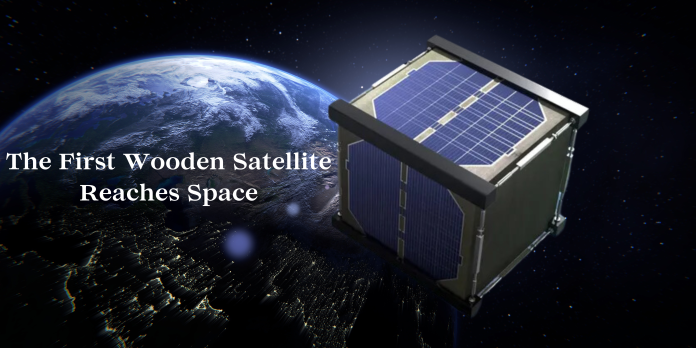Table of Contents
Have you ever imagined a wooden satellite floating in space? It might sound unusual, but it’s happening! A satellite made partly from wood has been launched into space for the first time. This unique satellite, created by scientists and engineers, marks an exciting step toward making space exploration more eco-friendly. In this blog post, we’ll explore why this wooden satellite was created, what it hopes to achieve, and what it means for the future of space travel. Let’s dive into the world of wooden satellites and see how they’re changing the game in space technology!
Why Make a Wooden Satellite?
Space exploration usually involves high-tech materials like metal, plastic, and strong alloys. These materials are built to survive the extreme conditions of space, where there’s no air, freezing temperatures, and intense radiation. So, why would anyone consider using wood to make a satellite?
The idea behind the wooden satellite is to create space equipment that’s less harmful to the environment. When satellites are launched, they eventually come back into Earth’s atmosphere and burn up, releasing particles into the air. Traditional materials can release harmful pollutants when they burn up, while wood burns cleaner. By using wood, scientists hope to reduce the environmental impact of space exploration. It’s a big idea that could make a real difference as we launch more and more satellites into space each year.
How Was the Wooden Satellite Made?
Making a satellite out of wood isn’t as simple as picking up some lumber from a hardware store! The wooden satellite, called WISA Woodsat, was carefully designed and built by a team of scientists, engineers, and wood experts. The team used a special type of wood called birch plywood, which is often used in furniture. But this wasn’t just any plywood; it underwent special treatments to prepare it for space.
To make sure the wood could withstand the conditions in space, the engineers coated it to protect it from radiation and extreme temperatures. Radiation is one of the biggest challenges because it can weaken materials over time. By treating the wood, the team was able to create a wooden satellite strong enough to survive in space.
What Is the Wooden Satellite’s Mission?
The WISA Woodsat isn’t just a cool experiment; it has a mission! The main goal of the wooden satellite is to test how well wood can survive in space. Scientists want to know if wood can be used to build parts of satellites or other space equipment. If the wood holds up well, it could lead to more eco-friendly satellites in the future.
The satellite has sensors and cameras to monitor the condition of the wood and see how it changes over time. The cameras will take pictures of the wood, which will be sent back to Earth for analysis. The data collected by the WISA Woodsat will help scientists learn more about how wood reacts to the harsh conditions of space. This mission will provide valuable information for future satellite designs.
Why Is This Important for the Environment?
One of the biggest reasons scientists are excited about the WISA Woodsat is because it could help make space exploration greener. Right now, the materials used in satellites can harm the environment when they burn up in Earth’s atmosphere. By switching to wood, a more natural and biodegradable material, we could lessen the environmental impact of space missions.
The wooden satellite also shows that we can think outside the box when it comes to sustainability. Using wood as a building material for satellites could be just the beginning. In the future, more eco-friendly materials might be used in space, reducing pollution and waste.
Challenges of Using Wood in Space
While the WISA Woodsat is an exciting experiment, using wood in space isn’t easy. Space is an extremely tough environment, and materials face challenges like:
- Temperature Fluctuations: In space, the temperature can go from extremely hot to cold. Wood has to be able to handle these changes without breaking or cracking.
- Radiation: Space is filled with radiation, which can weaken or damage materials over time. The wood in the WISA Woodsat was treated to help it survive the radiation, but scientists are watching closely to see how it holds up.
- Pressure and Durability: Wood is sturdy but might not be as strong as metals traditionally used in satellites. Engineers need to make sure it’s tough enough to handle the pressures and forces of space travel.
Despite these challenges, WISA Woodsat’s mission is to determine whether wood is a viable option for certain satellite parts. If successful, it could open up new possibilities for using eco-friendly materials in space exploration.
The Future of Eco-Friendly Space Exploration
The launch of the WISA Woodsat is just one of many recent efforts to make space exploration more sustainable. In recent years, scientists and engineers have been exploring different ways to reduce the impact of space travel on the environment. The space industry is taking big steps toward being more eco-conscious, from reusable rockets to biodegradable materials.
If the wooden satellite succeeds, it might inspire new designs and materials for future satellites. For example, we might see satellites with parts made from other natural materials like plant-based fibers or recycled metals. These small changes could make a big difference in how we impact the planet as we continue to explore the universe.
Conclusion
The journey of the WISA Woodsat into space marks an important moment in the search for eco-friendly solutions in space exploration. Using wood, a natural and renewable material, scientists are experimenting with ways to make space missions less harmful to our environment. The data from this wooden satellite will help researchers understand how wood and other green materials could be used in space.
As we look to the future, it’s exciting to think about what other eco-friendly innovations might come next. Could we one day have fully biodegradable satellites? Or rockets that produce no waste? The possibilities are endless, and the WISA Woodsat is just the beginning.
Would you like to see more eco-friendly inventions used in space? Let’s keep exploring how technology and nature can work together to create a greener future for us all!



































